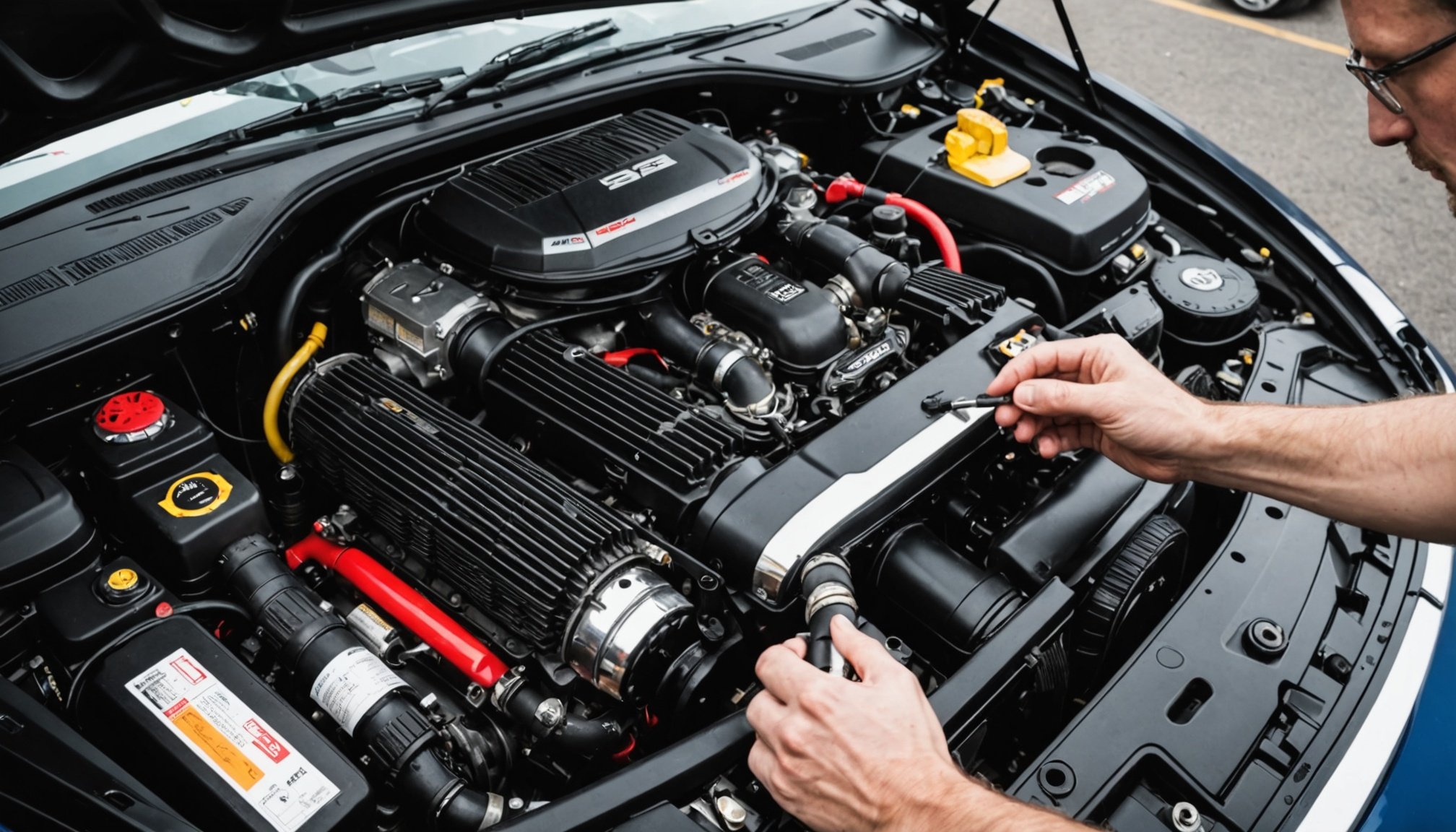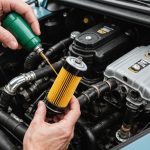Understanding the Importance of Engine Bay Detailing
A pristine engine bay is not just for aesthetics; it’s crucial for those entering UK car shows. When vehicles are judged, the engine bay presentation significantly impacts the scoring, underscoring the importance of car detailing. Judges assess cleanliness, attention to detail, and preservation of original components, making it essential for competitors to maintain an immaculate engine bay.
Beyond merely impressing judges, regular engine bay detailing provides lasting benefits to car owners. A clean engine bay helps in early detection of leaks or abnormalities, which can be crucial for engine maintenance. This proactive measure not only safeguards engine health but also enhances the overall longevity and performance of the vehicle.
Also to discover : Crucial safety tips for setting up a high-performance audio system in your uk car
For car enthusiasts, showcasing a well-maintained engine bay can elevate their profile within the car community. It’s a point of pride that reflects dedication and respect for their vehicle. At UK car shows, where the competition is fierce, having an impeccably detailed engine bay can be the difference between standing out and blending in. Understanding these aspects emphasises why regular and meticulous engine bay detailing is indispensable for both hobbyists and competitive entrants alike.
Essential Tools and Products for Engine Bay Detailing
To achieve impeccable engine bay detailing, having the right arsenal of tools and products is essential. While the art of detailing might seem straightforward, using the best car detailing tools can significantly impact results.
In parallel : Tinted windows in uk vehicles: your comprehensive guide to legal regulations
Include basic tools like brushes of varying sizes to reach intricate spots, a pressure washer for robust cleaning power, and detailing brushes for delicate areas. Selecting the best products is equally crucial. Use degreasers to tackle stubborn grime, while pH-balanced cleaners are ideal for sensitive components. Microfiber towels are non-negotiable for drying, known for their gentle touch and effectiveness in preventing scratches.
Safety is paramount during the detailing process. Always wear protective gear, including gloves and goggles, to guard against potentially harmful chemicals. Adequate ventilation is necessary, ensuring that fumes from cleaning supplies do not accumulate.
Finally, consider investing in quality protective sealants to preserve the shine and cleanliness of your engine bay. These form a protective barrier against dust and dirt, contributing to long-term maintenance between detailing sessions. Employing these cleaning supplies and safety practices guarantees a safe and efficient detailing experience, maintaining the aesthetic and functional integrity of your vehicle’s engine bay.
Step-by-Step Guide to Engine Bay Detailing
Delving into detailing techniques ensures a thorough understanding of the process.
Preparing Your Engine Bay
Begin by securing the vehicle in a well-ventilated space. Disconnect the battery to prevent accidents. Cover vulnerable areas like air intakes and electrical components to avoid water damage.
Cleaning Process
Select the appropriate step-by-step car detailing methods. Use a degreaser applied with a spray bottle for optimal coverage. Employ a mixture of brushes to agitate and lift grime, ensuring intricate areas receive meticulous attention. Rinse with controlled pressure, avoiding sensitive parts.
Protective Finishes
The application of protective coatings finalises the engine bay care procedure. Choose a high-quality polymer-based sealant to safeguard components against dirt and moisture. Apply evenly with a microfiber cloth, letting it cure as per product specifications.
Regular cleaning maintains pristine conditions while enhancing performance. Engage in these structured steps to effectively detail your engine bay, maintaining its aesthetic and functional integrity. Mastering these methods provides assurance in both car shows and daily maintenance.
Common Mistakes to Avoid in Engine Bay Detailing
Even seasoned detailers can fall prey to detailing mistakes that impact the outcome of their work. One common error is using the wrong cleaning product. It’s crucial to select the right formula for specific materials, as misuse can damage sensitive components. Following manufacturer recommendations regarding cleaning solutions ensures protection against potential harm.
Over-saturating areas with water or cleaning agents is another frequent mistake, heightening the risk of electrical damage. To avoid this, apply cleaners sparingly and use controlled water pressure during rinsing. Covering electrical components remains essential to safeguarding against liquid intrusion.
Neglecting ventilation and personal safety during detailing is also a misstep. Always conduct procedures in well-ventilated spaces and wear protective gear like gloves and goggles to reduce exposure to harmful chemicals.
Detailers often overlook the importance of post-cleaning maintenance. Applying protective coatings and sealants after cleaning vital for maintaining the detailed look and protecting the engine bay over time. Additionally, improper drying can leave water spots or streaks; thus, ensure thorough drying with microfiber towels.
Avoid these pitfalls by following best practices, ensuring engine maintenance and preparation aligned with car show expectations.
Special Considerations for Different Car Models
When engaging in engine bay detailing, varying car models demand particular attention. Adjustments are crucial, especially when distinguishing between classic and modern vehicles. For instance, classic cars often contain delicate, vintage parts necessitating gentle handling and specific cleaning agents to preserve original conditions. Conversely, modern cars require detailers to accommodate advanced electronics and tightly packed components, emphasizing precision and careful detailing techniques.
Performance vehicles present their own set of unique challenges. These machines are engineered for high output and often pack additional components like turbochargers, which demand more detailed cleaning approaches and better car detailing tools to access compact areas. Durable materials and high-heat exposure necessitate the use of specialised products that can withstand these conditions.
In the UK, regional considerations can influence detailing methods, as the climate plays a role in what contaminants are common. Urban areas might introduce more pollution-based grime, whereas rural spaces could involve more organic debris. For UK car shows, attention to these differing environmental factors ensures that engine bays remain in pristine condition, ready to impress judges and enthusiasts alike. Understanding these variations helps detailers provide the best results across all car models.
Visual Examples and Case Studies
Exploring detailing case studies and before and after examples can significantly enlighten budding enthusiasts and seasoned detailers alike. A detailed comparison of successful entries at car shows offers insights into optimal techniques and products employed to achieve that immaculate engine bay.
Consider a featured case study from a UK car show. One participant secured a leading position by focusing on meticulous brushing and polishing techniques, complemented by the application of high-quality protective sealants. This example demonstrates how comprehensive detailing practices go beyond the surface, maintaining both the aesthetic and functional integrity of the engine bay.
Visual references play an integral role in understanding complex detailing methods. These guides can walk detailers through each detailing technique, showcasing the transformation step-by-step. Capturing the engine bay’s development from grimy beginnings to a polished final product underscores the impact of using the right cleaning supplies and tools.
These examples validate the power of detailed cleaning, boosting confidence and inspiring enthusiasts to push the boundaries of their craft. By analyzing these successful ventures, detailers can adapt and refine their own approaches, ensuring excellence in future UK car show competitions.
FAQs about Engine Bay Detailing
Understanding the intricate world of engine bay detailing invites many questions. Here, we address some of the most frequently asked questions to dispel myths and offer clarity.
How often should engine bay detailing be performed?
Regular detailing every 3 to 6 months is recommended for maintaining a pristine engine bay, crucial for both routine maintenance and car show preparation. Keeping up with a routine can prevent long-term wear and preserve the vehicle’s aesthetic and functional integrity.
Can engine detailing damage components?
When done correctly, engine bay detailing does not damage components. It’s vital to use appropriate car detailing tools and pH-balanced cleaners to protect sensitive parts and ensure all electric components are covered. This prevents water or chemical-related damage.
Are there benefits of car detailing outside of aesthetics?
Certainly, detailing enhances engine maintenance by early detection of potential issues such as leaks or worn-out parts. This proactive step can significantly prolong engine life and performance.
By addressing these FAQs, enthusiasts can better appreciate the importance and best practices of engine bay detailing, empowering them to make informed decisions while preparing their cars for UK car shows or regular upkeep.
User Experiences and Testimonials
Diving into the world of car detailing reviews offers insights from enthusiasts who’ve perfected their craft in engine bay detailing. Engaging stories and feedback from participants at UK car shows provide practical, real-world experiences that shed light on what works and what doesn’t. These narratives are not just about showcasing success; they also reveal common pitfalls and how to avoid them.
Reading user testimonials highlights the satisfaction achieved from an immaculate engine bay. Many recount the pride in presenting a vehicle that not only looks pristine but is also maintained meticulously. This pride is often accompanied by technical gains, such as improved engine performance due to thorough cleaning.
In the detailing community feedback, enthusiasts often share their tailored approaches and the advantages of certain products. For example, switching to a high-quality sealant can lead to reduced dust accumulation, while customised brushes prove invaluable in cleaning intricate parts. Sharing these hands-on solutions fosters a supportive environment where both novices and seasoned detailers can thrive. The camaraderie found through these shared experiences becomes an invaluable resource, empowering individuals to enhance their detailing skills and attain excellence at UK car shows.











